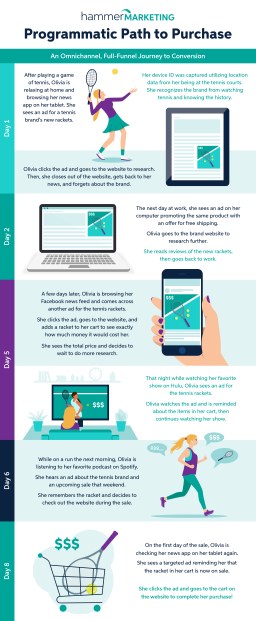Machine Learning in Marketing: Stop Fearing it. Start Leveraging It
Artificial intelligence (AI) takes this year’s prize for top buzzword, but machine learning (ML) is a close second, for good reason. It’s AI’s foundation; its metaphorical big brother, its building block and key ingredient1.
Loosely described as the use of data and algorithms to imitate how humans think and learn2, here’s how to differentiate between the two: While AI strives to mimic human intelligence, ML does not. Rather, it only goes as far as identifying patterns that tell a computer the best way to perform a specific task3.
But don’t write off smart data-assimilation just because it’s not AI. In fact, as AI finds its footing, works out kinks, and wards off naysayers, we suggest the opposite: Take baby steps toward AI in marketing by first harnessing its time-proven subset.
What’s Old Is New
Machine learning is anything but new. Here’s a nugget trivia teams will appreciate: ML traces its roots all the way back to the 1940s, when its cornerstone statistical methods were discovered and refined. In the decades after, it fueled the march toward deep learning – the term for computers’ ability to produce results comparable to those produced by human experts. This ultimately led to the development of AI.
In short, self-teaching technology has been bubbling up for decades. And, while it’s at the center of the cultural lexicon today thanks to AI, its nearing widespread adoption by its own merits. In the next few years, machine learning will transform countless aspects of life, including most facets of marketing. Its impending impact is so far-reaching, in fact, that marketers who don’t embrace machine learning will soon find themselves behind the times, using inefficient and ineffective systems offered at rates the market can no longer bear.
But first, let’s address the elephant in the room.
It’s Not as Scary as It Sounds – Promise!
Maybe it’s the word “machine.” Maybe it’s the intangibility of it all. Maybe it is all the movies we’ve seen that warn us about a future where the human race is enslaved to the too-smart-for-their-own-good robots! Whatever the reason, many people find the idea intimidating. But it doesn’t have to be.
While stressing the critical importance of adopting machine learning in marketing and advertising very soon, we nonetheless want to assure you that AI is not the bogeyman, exorbitantly expensive, or (to the best of our knowledge) a sign of doomsday! Rather, it is very much in reach of most businesses – even small and medium-sized businesses – and already used widely. In fact, there’s a good chance you’ve used this technology in some way, shape, or form today. Meaningfully leveraging it in your marketing and advertising efforts just means taking those familiar frameworks a few steps further.
Ways You’re Already Using Machine Learning
These concepts and names that sounded daunting and mysterious a few years ago are now everyday facets of marketing – and examples of how learned automation is already more mainstream than you might realize:
- Google Ads – by using algorithms to analyze data and pinpoint target audiences, popular Google Ads is the epitome of machine learning. Google Ads’ Performance Max campaigns takes ML to the next level, aggregating data across all of Google’s advertising surfaces for even sharper and more customizable ad targeting4.
- Social Media Ads – when you place ads on platforms like Facebook, Instagram, X (formerly known as Twitter), and LinkedIn, it’s self-teaching technology that matches them to users who embody target interests, behaviors, locations, and other carefully-defined demographics.
- CRMs with integrated email marketing functions – HubSpot, Pardot, and other customer relationship management platforms that offer suggestions based on browsing history and former purchases are also machine learning in action. The same as when you get a right-fit promotional email from a new-to-you brand or even that annual birthday email.
Machine Learning Marketing Tools to Consider
Does the above list feel like old hat? The driven initiatives below will soon, too. Implement them across marketing efforts today and experience the benefits of early adoption:
Chatbots – while hurdles exist and users are still warming up to them, chatbots – which use natural language processing (NLP) to engage in real-time conversations – are increasingly common and can benefit even the smallest businesses in big ways. Hammer Marketing’s suggestion: Choose one or two defined, low-stakes customer engagement channels and test drive chatbots there to gauge its efficacy.
Programmatic advertising – want to drop media-buying liaisons and harness the benefits of next-level customer segmentation? Programmatic advertising might be your new best friend. Programmatic is the automated, data-driven buying of digital space that targets your audience where they consume media, in real time. It is quickly replacing traditional media buying with real-time bidding, data-fueled targeting, and machine learning optimization of campaigns as they run. Put simply, get the benefit of personalized messaging for your right-fit audiences in the exact places they’re at (their preferred streaming channels, online shopping platforms, content platform, etc.), at the exact time they’re there. This type of hyper-targeted marketing will translate to better brand awareness, higher engagement, and ultimately more conversions.
Predictive analytics – the process of using data to predict behaviors and preferences, is transferrable to a near-endless array of uses. It’s already a staple among larger companies with vast omni-channel marketing efforts featuring numerous digital touch points and dependencies5.
Sentiment analysis – when ChatGPT launched earlier this year, thousands of users sampled it by asking it to write their own obituaries. The resulting obits – shared widely on social media – got the job done, but bore tones that struck many as clunky and insincere. Perhaps no surprise here: Machine learning has a solution for that! Sentiment analysis analyzes customer sentiment from various sources including social media comments, customer reviews, and feedback, assessing the tone of digital text and rewriting accordingly.
Pro Tip: Start with Programmatic Advertising
Of the emerging options above, programmatic advertising is one we recommend to businesses looking to dip their toe in the waters to see if the temperature’s right. Programmatic advertising is on pace to make up more than 90% of all US digital display ad spend in 2023. Even more impressive, by 2026, 86% of overall digital advertising revenue will come from programmatic ads. While it may seem like new tech based on machine learning and automation, it is clear that companies who are not leveraging programmatic advertising won’t even be contenders in just a few short years.
Ready to ride the sweet wave of benefits afforded by programmatic advertising – and maybe sample more future-minded machine learning tools, too? Reach out to us today!

- https://ai.engineering.columbia.edu/ai-vs-machine-learning/
- https://www.ibm.com/topics/machine-learning
- https://www.google.com/search?q=difference+machine+learning+and+ai
- https://support.google.com/google-ads/answer/10724817
- https://visit.bloomreach.com/predictive-analytics-ps-2

